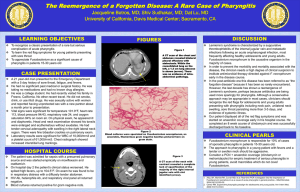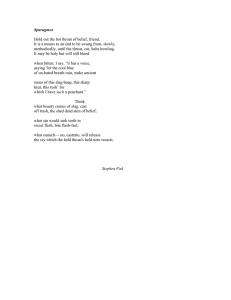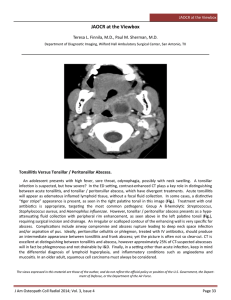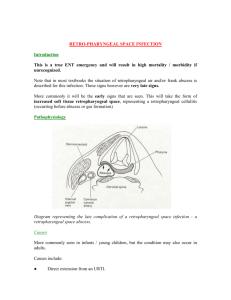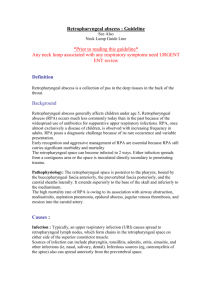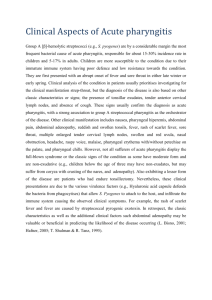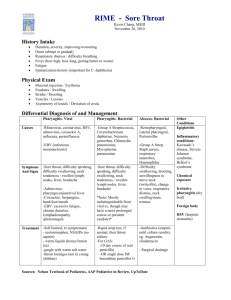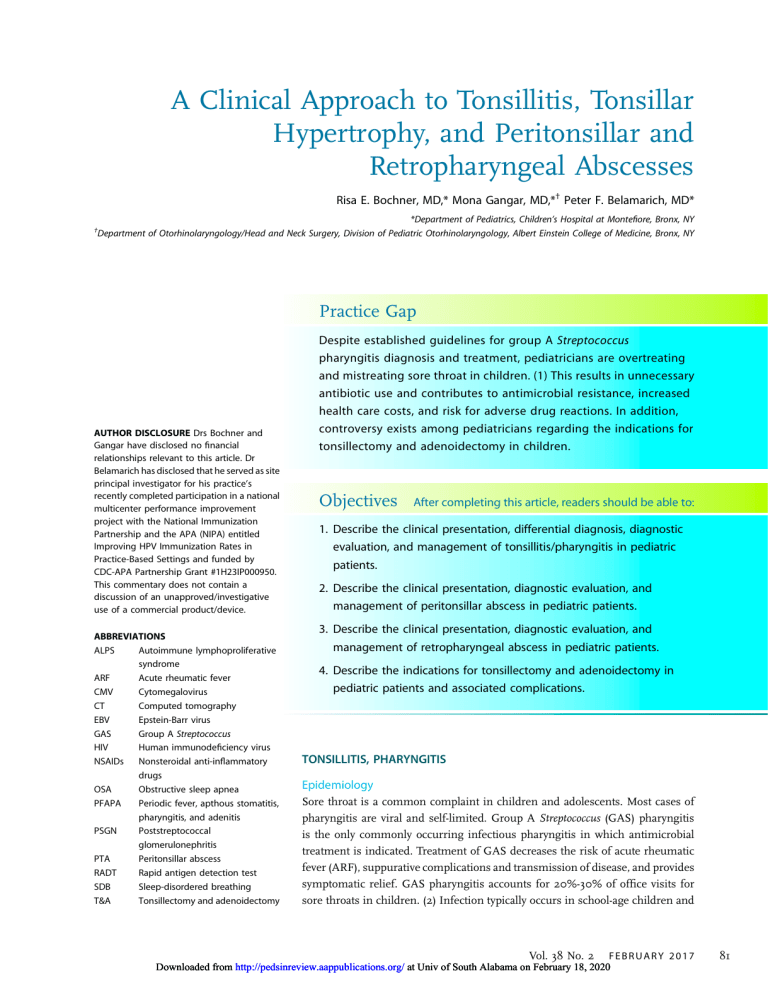
A Clinical Approach to Tonsillitis, Tonsillar Hypertrophy, and Peritonsillar and Retropharyngeal Abscesses Risa E. Bochner, MD,* Mona Gangar, MD,*† Peter F. Belamarich, MD* *Department of Pediatrics, Children’s Hospital at Montefiore, Bronx, NY Department of Otorhinolaryngology/Head and Neck Surgery, Division of Pediatric Otorhinolaryngology, Albert Einstein College of Medicine, Bronx, NY † Practice Gap AUTHOR DISCLOSURE Drs Bochner and Gangar have disclosed no financial relationships relevant to this article. Dr Belamarich has disclosed that he served as site principal investigator for his practice’s recently completed participation in a national multicenter performance improvement project with the National Immunization Partnership and the APA (NIPA) entitled Improving HPV Immunization Rates in Practice-Based Settings and funded by CDC-APA Partnership Grant #1H23IP000950. This commentary does not contain a discussion of an unapproved/investigative use of a commercial product/device. ABBREVIATIONS ALPS Autoimmune lymphoproliferative syndrome ARF Acute rheumatic fever CMV Cytomegalovirus CT Computed tomography EBV Epstein-Barr virus GAS Group A Streptococcus HIV Human immunodeficiency virus NSAIDs Nonsteroidal anti-inflammatory drugs OSA Obstructive sleep apnea PFAPA Periodic fever, apthous stomatitis, pharyngitis, and adenitis PSGN Poststreptococcal glomerulonephritis PTA Peritonsillar abscess RADT Rapid antigen detection test SDB Sleep-disordered breathing T&A Tonsillectomy and adenoidectomy Despite established guidelines for group A Streptococcus pharyngitis diagnosis and treatment, pediatricians are overtreating and mistreating sore throat in children. (1) This results in unnecessary antibiotic use and contributes to antimicrobial resistance, increased health care costs, and risk for adverse drug reactions. In addition, controversy exists among pediatricians regarding the indications for tonsillectomy and adenoidectomy in children. Objectives After completing this article, readers should be able to: 1. Describe the clinical presentation, differential diagnosis, diagnostic evaluation, and management of tonsillitis/pharyngitis in pediatric patients. 2. Describe the clinical presentation, diagnostic evaluation, and management of peritonsillar abscess in pediatric patients. 3. Describe the clinical presentation, diagnostic evaluation, and management of retropharyngeal abscess in pediatric patients. 4. Describe the indications for tonsillectomy and adenoidectomy in pediatric patients and associated complications. TONSILLITIS, PHARYNGITIS Epidemiology Sore throat is a common complaint in children and adolescents. Most cases of pharyngitis are viral and self-limited. Group A Streptococcus (GAS) pharyngitis is the only commonly occurring infectious pharyngitis in which antimicrobial treatment is indicated. Treatment of GAS decreases the risk of acute rheumatic fever (ARF), suppurative complications and transmission of disease, and provides symptomatic relief. GAS pharyngitis accounts for 20%-30% of office visits for sore throats in children. (2) Infection typically occurs in school-age children and Vol. 38 No. 2 F E B R U A R Y 2 0 1 7 Downloaded from http://pedsinreview.aappublications.org/ at Univ of South Alabama on February 18, 2020 81 adolescents, and is uncommon in children younger than 3 years. GAS pharyngitis occurs most commonly in the winter and early spring months and is spread through contact with oral and respiratory secretions of other humans. The relative predominance of the common viral causes varies by season with predominantly cold viruses (eg, rhinovirus, coronavirus, respiratory syncytial virus, parainfluenza) in the winter and enteroviruses in the warmer months. are possible in recent immigrants and unvaccinated children. A person infected with Francisella tularensis from ingestion of undercooked wild game meat may complain of pharyngitis. Traumatic or chemical pharyngitis can result from foreign body or caustic ingestion, respectively. Table 1 lists the full differential diagnosis and Table 2 infectious pathogens involved. Diagnosis Clinical Presentation The signs and symptoms of pharyngitis due to GAS and other pharyngitides overlap and there is no universally agreed upon algorithm to guide clinicians’ decision to forgo GAS testing. However, the history and physical examination should directly focus on differentiating between viral etiologies and GAS to guide the need for GAS testing. Fever, throat pain, and pharyngeal and/or tonsillar exudates are nonspecific findings. Concomitant cough, rhinorrhea, hoarseness, diarrhea, and/or the presence of oropharyngeal vesicles are highly suggestive of a viral etiology. Although nonspecific in isolation, the presence of scarletiniform rash, palatal petechiae, pharyngeal exudate, vomiting, and tender cervical nodes in combination increase the likelihood of GAS to greater than 50%. (3) Stridor, neck stiffness, or head tilt, limitation of neck movement, drooling, respiratory distress, or a toxic appearance are concerning for more serious diseases such as epiglottitis, retropharyngeal abscess, or Lemierre syndrome. Click on the following link, http://pedsinreview.aappublications.org/content/38/2/81. figures-only, for a video demonstration of the oropharyngeal examination technique. Pharyngitis is a clinical diagnosis; additional testing should be focused on identifying children with the treatable causes of pharyngitis, atypical symptoms, and prolonged illness. Children and adolescents with signs and symptoms of acute pharyngitis in the absence of overt viral symptoms should be tested for GAS pharyngitis either with throat culture or rapid antigen detection test (RADT). Throat culture is the gold standard and most cost-effective test, with a sensitivity of 90% to 95%. The RADT has a specificity of 95% but variable sensitivity (ie, false-negative results occur).(2) A negative RADT should therefore be followed by throat culture for confirmatory testing. The sensitivity of throat culture and RADT are dependent on proper specimen collection that requires vigorous swabbing of both tonsils TABLE 1. Differential Diagnosis of Tonsillitis/ Pharyngitis Infectious Viral Bacterial Fungal Peritonsillar abscess Lemierre syndrome Epiglottitis Tracheitis Croup Lateral/retropharyngeal abscess Uvulitis Allergic/inflammatory Kawasaki disease PFAPA Stevens-Johnson syndrome Behçet syndrome Angioedema Anaphylaxis Environmental exposure Foreign body ingestion Chemical exposure Irritative pharyngitis Referred pain Psychogenic pharyngitis Referred from dental abscess, otitis media, cervical adenitis Oncologic Lymphangioma, hemangioma of the airway Differential Diagnosis Recognized viral etiologies of acute pharyngitis include adenovirus, rhinovirus, Epstein-Barr virus (EBV), parainfluenza, influenza, coxsackie, measles, and herpes simplex virus. Mycoplasma pneumonia is a common bacterial cause of pharyngitis. Pharyngitis can be a predominant symptom of acute retroviral syndrome secondary to infection with human immunodeficiency virus (HIV). Sexually active adolescents may also present with an acute pharyngitis caused by infection with Neisseria gonorrhea. Mononucleosis, commonly caused by EBV or cytomegalovirus (CMV) infection, often presents with an exudative pharyngitis, tender cervical lymphadenopathy, and constitutional symptoms. Immunocompromised patients are susceptible to opportunistic infections such as pharyngeal candidiasis (thrush) caused by Candida albicans infection. Corynebacterium diphtheria and Haemophilus influenzae b are uncommon causes of acute pharyngitis in developed countries but 82 PFAPA¼periodic fever, apthous stomatitis, pharyngitis, and adenitis. Pediatrics in Review Downloaded from http://pedsinreview.aappublications.org/ at Univ of South Alabama on February 18, 2020 TABLE 2. Infectious Pathogens That Cause Tonsillitis/Pharyngitis Viral Epstein-Barr virus, cytomegalovirus, adenovirus, enterovirus (coxsackie A and B), herpes simplex virus, HIV, influenza, RSV, parainfluenza, rhinovirus, coronavirus Bacterial Group A Streptococcus, Mycoplasma pneumonia, Corynebacterium diphtheria, Neisseria gonorrhea, Arcanobacterium haemolyticum, other Streptococci (group G and C), Haemophilus influenza type b, Francisella tularenis, Fusobacterium necrophorum, Chlamydia pneumoniae, Chlamydia trachomatis, Yersinia enterolitica, Coxiella burnetii Fungal Candida species HIV¼human immunodeficiency virus; RSV¼respiratory syncytial virus. and posterior pharynx without touching the tongue or buccal mucosa. Serologic tests are not routinely used in the diagnosis of acute GAS pharyngitis because antibody response does not occur until 2 to 3 weeks after initial infection. In general, testing for GAS in children younger than 3 years and in asymptomatic family or classroom contacts is not recommended. The judicious and targeted use of the RADT is warranted. The ease of use and availability of the RADT in children with complaints of sore throat can lead to overuse in children with viral pharyngitis. This can, in turn, lead to the identification and unnecessary treatment of GAS carriers who are exposed to unnecessary courses of antibiotics. Standing orders for ancillary personnel to perform a RADT in every child with a chief complaint of sore throat before a clinical evaluation to assess for a viral etiology should be avoided. Additional testing may be useful to diagnose non-GAS infectious tonsillopharyngitis. The need for additional testing should be individualized based on clinical signs and symptoms. With respect to EBV infection, in many cases, a clinical diagnosis can be made. However, in cases of diagnostic uncertainty and when an explanation is desired for persistent symptoms, a definitive diagnosis may be sought. There are several approaches, but no consensus exists regarding a diagnostic algorithm for EBV infection. The usefulness of the available tests varies with the duration of illness and age of the patient. In children older than 4 years who have symptoms for 2 weeks, a positive heterophile antibody test in conjunction with an absolute increase in the number of atypical lymphocytes is often considered diagnostic. The EBV viral capsid antigen immunoglobulin M test may be used in younger patients. If Neisseria gonorrhea is suspected, nucleic acid amplification testing or culture on special media (Thayer-Martin or Martin-Lewis medium) is necessary for diagnosis. Specimens should be obtained using swabs with plastic or wire shafts and rayon, polyester textile fabric, or calcium alginate tips because wood shafts and cotton tips may be toxic to the organism. (4) If acute retroviral syndrome is suspected, the combination HIV antibody/antigen test should be performed because it is the most sensitive immunoassay for HIV. Serologic testing is used to diagnose tularemia and should be ordered in patients with exposure history. Treatment Early antibiotic therapy for GAS pharyngitis (up to 9 days after illness onset) has been shown to prevent ARF, decrease symptom duration and severity, and reduce suppurative complications. (2) Whether antibiotic therapy reduces the risk of poststreptococcal glomerulonephritis (PSGN) is uncertain. Oral penicillin V is the treatment of choice for GAS pharyngitis given its proven efficacy, narrow spectrum, safety, and low cost. Oral amoxicillin may be used as a more palatable alternative that is equally effective. A single dose of intramuscular penicillin G benzathine can be used for patients who cannot tolerate a 10-day course of oral therapy, in patients with a history of poor compliance to oral therapy, and in those at increased risk for ARF. Firstgeneration cephalosporins are an acceptable alternative for patients who report a penicillin allergy but do not have a history of anaphylaxis. Macrolides or clindamycin are acceptable alternatives in patients with a history of anaphylactic reactions to penicillin or with an unclear allergy history. Sulfonamide antibiotics, tetracyclines, and fluoroquinolones should not be used for treatment of GAS infections. Improvement is expected by 3 to 4 days after antibiotic initiation. Children are no longer considered contagious after 24 hours of treatment and may return to school. Table 3 provides specific antibiotic dosing information. (5) Treatment of viral pharyngitis is symptomatic. Systemic analgesics are the mainstay of treatment and may be used for moderate to severe throat pain (nonsteroidal antiinflammatory drugs [NSAIDs], acetaminophen). Although glucocorticoids may reduce pain from sore throat, there is limited high-quality evidence for this indication and, therefore, their use is not recommended in children at this time. Topical therapies include oral rinses, sprays, and lozenges. Oral rinses containing salt water have not been systematically studied. Rinses containing topical anesthetics (eg, lidocaine) and topical NSAIDs (eg, benzydamine hydrochloride) have been studied systematically, mainly in patients with postoperative Vol. 38 No. 2 F E B R U A R Y 2 0 1 7 Downloaded from http://pedsinreview.aappublications.org/ at Univ of South Alabama on February 18, 2020 83 TABLE 3. Antibiotic Treatment of GAS Tonsillitis/Pharyngitis ANTIBIOTIC DOSE ROUTE DURATION Penicillin V 400,000 U (250 mg) 2-3 times per day for children <27 kg 800,000 U (500 mg) 2-3 times per day for children >27 kg Oral 10 days Penicillin G benzathine 600,000 U (375 mg) for children <27 kg 1,200,000 U (750 mg) for children >27 kg Intramuscular 1 time dose Amoxicillin 50 mg/kg daily (max 1,000-1,200 mg) Oral 10 days First-generation cephalosporins Cephalexin 20 mg/kg/dose twice a day (max 500 mg/dose) Oral 10 days Clindamycin 20 mg/kg/day in 3 divided doses (max 1.8 g/day) Oral 10 days Macrolides Azithromycin 12 mg/kg/day max 500 mg daily Clarithromycin 7.5 mg/kg/dose BID max 250 mg/dose Oral 5 days azithromycin 10 days clarithromycin BID¼twice a day; GAS¼group A Streptococcus. throat pain or throat pain because of chemotherapy-induced mucositis. The current evidence base is insufficient to draw conclusions. Sprays and medicated lozenges containing local anesthetics (benzocaine, phenol) are no more effective than candy at relieving throat pain and are not recommended because of the risk for methemoglobinemia and allergic reactions. daycare center, and “ping-pong” episodes of GAS pharyngitis among family members. (2) Children in these exceptional circumstances should be retested and re-treated despite suspicion for carrier status. GAS carriage is difficult to eradicate with conventional antimicrobials. Oral clindamycin at a dose of 30 mg/kg per day divided into 3 doses (maximum 900 mg/day) for 10 days is the recommended treatment for GAS carriers. (2) Group A Streptococcus Carriers Asymptomatic patients with cultures that remain positive after a full course of treatment are likely carriers. Carrier status may be as high as 25% of asymptomatic children in high prevalence areas. (2) Carriers are not at increased risk for ARF or suppurative complications. Carriage of GAS can persist for many months but the risk of transmission from a carrier to another person is low. (2) A “test of cure” for GAS and repeated antimicrobial courses are, therefore, not indicated. Although it is possible that the child with frequent sore throats and positive cultures for GAS has recurrent GAS infections, it is more likely the child is a GAS carrier with recurrent viral illnesses. Compliance with oral therapy should be assessed, and the decision to treat should be made based on clinical findings and epidemiologic factors (patient age, season, history of contact with a person with GAS infection, family history of ARF or PSGN). Because it is not possible to differentiate a carrier state from an active GAS infection in real time, treatment is often chosen. The best strategy to avert this is to avoid overtesting and retesting. Exceptions to this rule are a personal or family history of ARF, community outbreaks of ARF or PSGN, GAS pharyngitis outbreaks in “closed” communities such as a 84 PERITONSILLAR ABSCESS Epidemiology Peritonsillar cellulitis and abscess are among the most common deep space neck infections in children and adolescents. Peritonsillar abscess (PTA) is defined as a suppurative infection of the tissue between the palatine tonsil capsule and the pharyngeal muscles. The term peritonsillar cellulitis is used when tissue inflammation is present without a discrete pus collection. According to one US study, the incidence of PTA was 9.4 per 100,000 children younger than 20 years in 2009. (6) Its incidence peaks in adolescence with an average age of 13.6 years. (6) Most PTAs are polymicrobial, with Streptococcus and Fusobacterium species being the most common etiologic agents. Clinical Presentation Patients with PTAs most commonly present with sore throat and fever. Other symptoms include dysphagia, odynophagia, voice change, drooling, and trismus (due to spasm of the internal pterygoid muscle). Physical examination signs include uvular deviation toward the contralateral side, Pediatrics in Review Downloaded from http://pedsinreview.aappublications.org/ at Univ of South Alabama on February 18, 2020 ipsilateral tonsillar bulging, the presence of a tender neck mass, and cervical and/or submandibular lymphadenopathy. Patients may appear anxious or irritable and be unable to take anything by mouth. Younger children are less likely to complain of sore throat and are more likely to present with a neck mass. (7) Clinicians should suspect PTA in patients with symptoms of pharyngitis who have a prolonged or progressive course. Untreated PTA can lead to serious complications such as airway obstruction, aspiration pneumonia, carotid artery pseudoaneurysm or rupture with resulting sepsis and hemorrhage, and septic thrombophlebitis of the internal jugular vein (Lemierre syndrome). The differential diagnosis is similar to that for tonsillopharyngitis (Table 1). Diagnosis Diagnosis of a PTA is largely made on clinical suspicion, and laboratory evaluation is usually unnecessary. Similarly, imaging studies are generally not required. If the diagnosis is in question, intraoral ultrasonography was recently found to be an effective tool to determine the presence or absence of a fluid collection. Although contrast-enhanced computed tomography (CT) of the neck is also effective in determining the presence of a PTA, its use should be avoided if possible because of the close proximity of radiationsensitive tissues such as the thyroid gland. Clinicians are encouraged to consult the American College of Radiology Appropriateness Criteria before considering CT for this indication. (8) According to the criteria, any recommended imaging studies for children who present with neck masses must take into consideration the risk of sedation and radiation dose. CT of the neck with contrast has a relative radiation level of 0.3 to 3 millisievert compared to zero radiation risk with ultrasonography. However, CT of the neck with contrast may be appropriate if there is concern for malignancy or a deep neck abscess that may require surgical drainage. Treatment Because PTA is a disease process found more commonly in adolescents, drainage while awake is considered the treatment of choice. This can often be performed under local anesthesia in the emergency department or in the office of a pediatric otolaryngologist. For younger or uncooperative patients, general anesthesia may be required. Controversy exists regarding needle aspiration versus incision and drainage. With the patient in an upright sitting position, topical or infiltrative anesthesia is applied and an 18-gauge needle is used to localize and aspirate the abscess pocket, usually in the soft palate superior to the superior tonsillar pole. If an incision is to be made, it is created at the area of maximal bulging in a lateral to medial fashion. A clamp can then be used to open the abscess pocket and drain additional purulent material. An experienced clinician, usually an otolaryngologist, should perform these procedures. Cultures of any recovered material should be performed. Patients can usually be discharged after the procedure with oral antibiotic therapy for 7 to 10 days. Penicillins, cephalosporins, or clindamycin are good empirical options while awaiting culture results. Indications for admission include the need for intravenous hydration due to poor oral intake, pain management, no reliable outpatient follow-up, and management of complications after drainage such as severe bleeding or respiratory distress secondary to aspiration of abscess contents into the patient’s airway. In the past, quinsy tonsillectomy (tonsillectomy in the presence of a PTA) was used as a drainage treatment; however, this has largely been abandoned as a first-line treatment. RETROPHARYNGEAL ABSCESS Epidemiology A retropharyngeal abscess is a suppurative deep neck infection that occurs in the potential space extending from the base of the skull to the posterior mediastinum between the posterior pharyngeal wall and prevertebral fascia. The retropharyngeal space houses a chain of lymph nodes that drains the nasopharynx, adenoids, eustachian tubes, middle ears, and posterior paranasal sinuses. The pathogenesis of retropharyngeal abscess is thought to frequently follow an upper respiratory tract infection with resulting suppuration of the retropharyngeal lymph nodes and abscess formation. The abscess may also form secondary to trauma from an ingested foreign body or instrumentation in the posterior oropharynx. According to one US study, the incidence of retropharyngeal abscess has increased from 2.98 to 4.10 per 100,000 children younger than 20 years from 2003 to 2012. (9) Incidence is highest among children younger than 5 years and in boys. (9) The microbiology of retropharyngeal abscesses is often polymicrobial. Streptococcal, staphylococcal species, and respiratory anaerobes are the most common organisms isolated. Clinical Presentation Presentation of retropharyngeal abscess is variable and no particular constellation of symptoms and signs is diagnostic. Patients commonly present with complaints of fever, neck pain, and dysphagia. Other symptoms include sore throat, odynophagia, decreased oral intake, drooling, Vol. 38 No. 2 F E B R U A R Y 2 0 1 7 Downloaded from http://pedsinreview.aappublications.org/ at Univ of South Alabama on February 18, 2020 85 dyspnea, and even chest pain if there is mediastinal extension. Common physical examination signs include cervical lymphadenopathy, limited neck movement or meningismus, torticollis, and the presence of a palpable neck mass. Tonsillar displacement, dysphonia, trismus, and stridor may also be appreciated. Patients may appear ill and anxious, and exhibit posturing. Care must be taken when examining these children because the stress of the oropharynx examination can result in partial or complete airway obstruction. There is also a risk of abscess rupture. For ill-appearing patients with signs of partial upper airway obstruction such as stridor or stertor, performing the oropharynx examination in the operating room where an emergent surgical airway can be established, if necessary, is recommended. Untreated retropharyngeal abscess can lead to serious infectious and obstructive complications similar to those described for PTA. Additional complications include atlantoaxial dislocation and mediastinitis because of the proximity of the retropharyngeal space to these critical structures. The differential diagnosis includes causes of sore throat and airway obstruction as outlined in Table 1. In patients presenting with neck pain or stiffness, the differential diagnosis should also include meningitis, cervical spine arthritis, spinal trauma, dystonic reaction, tuberculous abscess of the spine, and various toxin-mediated diseases (tetanus, black widow spider bite, scorpion bite). Diagnosis If the diagnosis is apparent from history and physical examination findings, laboratory studies may not be necessary. In cases of diagnostic uncertainty, a complete blood cell count may be helpful to identify signs of inflammation (leukocytosis, thrombocytosis). A throat culture for GAS and a peripheral blood culture, if positive, can help guide antibiotic therapy. Other tests to consider, especially in patients with unusual presentations, include EBV, CMV and toxoplasmosis titers, purified protein derivative placement, erythrocyte sedimentation rate, and C-reactive protein. Imaging should be reserved for cases in which the diagnosis is in question, if operative management is required or no improvement is seen after 48 to 72 hours of intravenous antibiotic therapy. Lateral neck radiography is often the first imaging modality pursued and may reveal thickening of the prevertebral soft tissues (Fig 1). At the level of the second cervical vertebrae, thickening greater than 7 mm is considered abnormal, or greater than 14 mm at the level of the sixth cervical vertebrae. Unfortunately, lateral neck radiography has a high false-positive rate secondary to variations in positioning, swallowing, and respiration. In addition, plain radiography cannot differentiate between phlegmon 86 Figure 1. Lateral neck radiograph showing widening of the prevertebral soft tissue suggestive of retropharyngeal abscess. and frank abscess formation. A chest radiograph should be obtained if mediastinitis is suspected. Contrast-enhanced neck CT is the imaging modality of choice to differentiate abscess from phlegmon and for operative planning (Figs 2 and 3). However, judicious use of CT is recommended given the harmful effects of radiation exposure in children. For example, one should limit CT to children who have failed conservative treatment and require operative management. Ultrasonography is generally not helpful unless an associated neck mass is identified. Treatment When considering management of retropharyngeal abscesses, the first consideration is the airway. Supplemental humidified oxygen, nasal trumpet, or positive pressure ventilation may be sufficient for moderate airway obstruction, but intubation or tracheotomy is rarely necessary. Although this topic continues to be debated, deep neck space infections are commonly treated initially with 24 to 48 hours of broadspectrum parenteral antibiotics (eg, clindamycin, cephalosporins, b-lactamase penicillins), because approximately 60% of infections may resolve with medical management alone. For patients who fail to improve or progress despite antimicrobial therapy, surgical treatment should be considered. Generally a transoral approach is used to drain the abscess via an incision in the posterior pharyngeal Pediatrics in Review Downloaded from http://pedsinreview.aappublications.org/ at Univ of South Alabama on February 18, 2020 wall. For abscesses with cervical extension lateral to the great vessels, inferior to the hyoid bone or into other neck spaces, a transcervical approach is generally applied. Purulent fluid is sent for culture and a biopsy may be taken if another process is suspected. CT-guided drainage by interventional radiology can also be considered for abscesses in difficult to access locations. Recurrent abscesses should be considered for patients who fail to improve or whose symptoms return after a short period of improvement. TONSILLAR AND ADENOIDAL HYPERTROPHY Indications for Tonsillectomy and Adenoidectomy Tonsillectomy and adenoidectomy (T&A) is the second most common surgery performed in the United States. (10) The 2 main indications for tonsillectomy are sleepdisordered breathing (SDB) and severe recurrent throat infections. Severe throat infection, as defined by the Paradise criteria (11) is a documented sore throat plus 1 of the following: temperature greater than 38.3°C, cervical lymphadenopathy (tender nodes or >2 cm in diameter), tonsillar exudate, positive GAS RADT or culture. Recurrent infection is defined as more than 7 documented episodes of severe throat infections in 1 year, more than 5 episodes per year for 2 consecutive years, or more than 3 episodes per year for 3 consecutive Figure 2. Contrast axial computed tomographic image showing heterogenous material with areas of hypodensity (circled) representing phlegmon with developing retropharyngeal abscess. The airway is displaced anteriorly (arrow) secondary to the retropharyngeal process. Figure 3. Contrast sagittal computed tomographic image demonstrating a retropharyngeal abscess (circled). years. Patients who do not meet these strict criteria should be evaluated for the presence of modifying factors that may make them candidates for T&A (eg, family or personal history of ARF, history of PTA, Lemierre syndrome, periodic fever, apthous stomatitis, pharyngitis, and adenitis [PFAPA], and multiple antibiotic allergies). T&A is now being performed much more commonly for obstructive rather than infectious indications. (12) It should be considered for patients with SDB who also have comorbid conditions (eg, growth restriction, poor school performance, nocturnal enuresis, behavioral problems). (12) The role of polysomnography before T&A is controversial. According to the American Academy of Otolaryngology and Head and Neck Surgery, polysomnography is not necessary before T&A in otherwise healthy children with SDB but may be helpful in certain situations: in children predisposed to obstructive sleep apnea (OSA) and, therefore, at risk for perioperative respiratory complications (eg, children with trisomy 21, morbid obesity, neuromuscular disorders, or craniofacial abnormalities). (12)(13) The American Academy of Pediatrics recommends screening of otherwise healthy children and adolescents for snoring and signs/ symptoms of SDB at routine health maintenance visits. They also recommend polysomnography or referral to a specialist such as a pediatric otolaryngologist for those who have positive screening results. (14) Polysomnography, although not necessary before T&A for SDB, is helpful to quantify the severity of OSA and the risk for postoperative complications. The current literature generally supports T&A as an acceptable treatment for Vol. 38 No. 2 F E B R U A R Y 2 0 1 7 Downloaded from http://pedsinreview.aappublications.org/ at Univ of South Alabama on February 18, 2020 87 SDB/OSA. Studies have reported polysomnography normalization and improvement in parent- and patientreported quality of life measures after T&A. However, OSA resolution is less likely in children with obesity, those of African American race, and those who have severe OSA at baseline. (13) The decision to proceed with T&A should, therefore, be made jointly between the physician and patient family after counseling about risks, benefits, and consideration of individual preferences. (12) Shared decision-making tools such as option grids (15) are helpful to empower patients with the information necessary for them to take an active part in the decision-making process. Watchful waiting with close monitoring for and documentation of further episodes of tonsillopharyngitis, development of modifying factors, and/or development of comorbid conditions associated with SDB are recommended for patients who do not meet the aforementioned criteria. Figure 4 shows our recommended clinical decision pathway. The main indication for adenoidectomy alone is severe nasal obstruction. Symptoms of severe nasal obstruction include mouth breathing, hyponasal speech, and impaired olfaction. Symptoms must present for more than 1 year and must persist despite conservative treatment such as a trial of antimicrobial therapy and nasal corticosteroids to exclude infectious and allergic causes of adenoidal hypertrophy. Relative indications for adenoidectomy include refractory chronic sinusitis, recurrent acute otitis media, and chronic otitis media with effusion in children who failed tympanostomy tube placement. Complications The overall frequency of postoperative complications after T&A is around 19%. (16) Postoperative bleeding occurs in Figure 4. Decision tree for tonsillectomy. GAS¼group A Streptococcus, PFAPA¼periodic fever, apthous stomatitis, pharyngitis, and adenitis. 88 Pediatrics in Review Downloaded from http://pedsinreview.aappublications.org/ at Univ of South Alabama on February 18, 2020 TABLE 4. Conditions Associated with Tonsillar and Adenoidal Hypertrophy Infection Allergy Chronic inflammation Malignancy- lymphoma or squamous cell carcinoma of the tonsil Autoimmune lymphoproliferative syndrome Lysosomal storage diseases and mucopolysaccharidoses Idiopathic approximately 5% of T&As. (16) Bleeding is characterized as primary if it occurs within the first 24 hours after surgery and secondary if it is more than 24 hours after surgery. Secondary hemorrhage is thought to be due to premature separation of eschar from the tonsillar bed and occurs most frequently on postoperative day 5 to 6. The bleeding usually stops spontaneously but sometimes requires repeat surgical intervention. Preoperative assessment of personal or family history of bleeding dyscrasias and postoperative anticipatory guidance regarding this potential complication are therefore essential. Respiratory complications occur in approximately 9.4% of T&As. (16) These may be minor such as increased postoperative snoring or mouth breathing but may also be more serious. Perioperative desaturations, apneas or respiratory failure requiring supplemental oxygen, continuous positive airway pressure, oral or nasal airway insertion or reintubation, and assisted ventilation have been reported. Children with OSA are 5 times more likely to have perioperative respiratory complications than those undergoing T&A for other indications. (16) Velopharyngeal insufficiency, characterized by hypernasal speech, nasal air emission, and nasal liquid regurgitation, may also occur after T&A. Patients with cleft palate, submucous clefts, bifid uvula, neuromuscular disorders, and 22Q11 syndrome are particularly at risk for this complication. When it occurs postoperatively, velopharyngeal insufficiency is most often temporary. Nasopharyngeal stenosis may also occur after adenoidectomy. This presents with hyponasal speech and difficulty breathing through the nose. Other complications of T&A include anesthesia-related bronchospasm/laryngospasm, electrocautery burn injuries, and temporomandibular joint dysfunction from the mouth gag used during the procedure. Postoperative pain, nausea, vomiting, and dehydration are also common. Acetaminophen with or without ibuprofen is recommended for postoperative pain control with sparing use of opioids due to increased risk for respiratory complications with this class of medication. (12) As with any surgical procedure, there is also a risk of infection. However, the American Academy of Otolaryngology–Head and Neck Surgery recommends against routine perioperative antimicrobial prophylaxis. (12) Studies have documented weight gain as a potential complication after T&A due to the decreased work of breathing postoperatively. It is therefore important to counsel all patients planning to undergo T&A about healthy nutrition and physical activity. Other rare complications of T&A include Grisel syndrome, a nontraumatic subluxation of the atlantoaxial joint that presents as severe neck pain and torticollis. Children with trisomy 21 are more predisposed to this complication. The risk of mortality with T&A is 1 in 16,000 to 35,000. (16) In general, one should consider postoperative hospitalization in children who are younger than 3 years, children with severe OSA at baseline, and those with significant preoperative comorbid conditions that put them at increased risk for postoperative respiratory complications (eg, obesity, cardiac disease, neuromuscular disorders, prematurity, and craniofacial abnormalities). (13) Conditions Associated with Tonsillar/Adenoidal Hypertrophy In addition to acute or chronic infection, other processes can lead to tonsillar and adenoidal hypertrophy. In the case of unilateral tonsillar enlargement, it is important to evaluate for potential neoplastic processes such as lymphoma or human papillomavirus–associated squamous cell carcinoma of the tonsil. Although very rare, Video. Click here to view the video. Video shows the oropharyngeal examination technique. Vol. 38 No. 2 F E B R U A R Y 2 0 1 7 Downloaded from http://pedsinreview.aappublications.org/ at Univ of South Alabama on February 18, 2020 89 autoimmune lymphoproliferative syndrome is also possible. In addition, some lysosomal storage diseases such as the mucopolysaccharidoses are associated with tonsillar and adenoidal hypertrophy (Table 4). • On the basis of expert opinion (level D), decision to proceed with tonsillectomy and adenoidectomy (T&A) should be made jointly between the physician and patient family after counseling them about the risks, benefits, and consideration of individual preferences. Cases that do not meet the criteria for T&A (severe recurrent throat infections, moderate throat infection with modifying factors, sleepdisordered breathing with comorbid conditions and/or abnormal polysomnography) should be managed by watchful waiting. Summary • On the basis of strong research evidence (level A), children older than 3 years with sore throat in the absence of viral symptoms should be tested for group A Streptococcus (GAS) pharyngitis. • On the basis of strong research evidence (level A), oral or intramuscular penicillin and amoxicillin are first-line treatments for GAS pharyngitis. To view the teaching slides that accompany this article, visit http://pedsinreview.aappublications.org/ content/38/2/81.supplemental. • On the basis of research evidence (level B), first-generation cephalosporins, macrolides, or clindamycin are acceptable alternatives for penicillin-allergic patients. • On the basis of research evidence (level B), asymptomatic carriers of GAS should not be treated with antibiotic therapy. • On the basis of limited evidence (level C), diagnosis of peritonsillar abscesses can usually be made based on clinical suspicion and laboratory testing/imaging are often unnecessary. • On the basis of research evidence (level C), imaging for retropharyngeal abscess should be reserved only when the diagnosis is in question, when operative management is required, or when there is lack of improvement after 48 to 72 hours of intravenous antibiotic therapy. References for this article are at http://pedsinreview.aappublications.org/content/38/2/81. Parent Resources from the AAP at HealthyChildren.org • Tonsillitis: https://www.healthychildren.org/English/health-issues/conditions/ear-nose-throat/Pages/Tonsillitis.aspx • The Difference between a Sore Throat, Strep & Tonsillitis: https://www.healthychildren.org/English/health-issues/conditions/ear-nosethroat/Pages/The-Difference-Between-a-Sore-Throat-Strep-and-Tonsillitis.aspx For a comprehensive library of AAP parent handouts, please go to the Pediatric Patient Education site at http://patiented.aap.org. 90 Pediatrics in Review Downloaded from http://pedsinreview.aappublications.org/ at Univ of South Alabama on February 18, 2020 PIR Quiz There are two ways to access the journal CME quizzes: 1. Individual CME quizzes are available via a handy blue CME link under the article title in the Table of Contents of any issue. 2. To access all CME articles, click “Journal CME” from Gateway’s orange main menu or go directly to: http://www.aappublications. org/content/journal-cme. 1. A previously healthy 9-year-old boy is seen in the office with a 1-day history of fever and sore throat. He does not have rhinorrhea, cough, or diarrhea. Examination shows pharyngeal erythema with tonsillar exudate and bilateral tender anterior cervical lymphadenopathy. He is not allergic to any medication but has a history of diarrhea with amoxicillin, which he took 2 months ago for pharyngitis. Which of the following is the most appropriate next step in management? A. B. C. D. Amoxicillin for 10 days. Antistreptolysin O antibody titer. Azithromycin for 5 days. Throat swab for group A Streptococcus rapid antigen detection test (RADT) and culture if RADT is negative. E. Throat swab for RADT and culture regardless of RADT result. 2. A 7-year-old girl and her mother come to the office because the mother received a note from the girl’s school that 2 children in her class were being treated for “Strep throat.” The girl is currently asymptomatic and has a history of 2 episodes of pharyngitis in the past year, and was treated with azithromycin without a pharyngeal swab. She and other household contacts do not have a history of rheumatic fever or glomerulonephritis. Her examination results are normal. Which of the following is the most appropriate next step in management? A. B. C. D. E. REQUIREMENTS: Learners can take Pediatrics in Review quizzes and claim credit online only at: http:// pedsinreview.org. To successfully complete 2017 Pediatrics in Review articles for AMA PRA Category 1 CreditTM, learners must demonstrate a minimum performance level of 60% or higher on this assessment, which measures achievement of the educational purpose and/or objectives of this activity. If you score less than 60% on the assessment, you will be given additional opportunities to answer questions until an overall 60% or greater score is achieved. Amoxicillin for 10 days. Antistreptolysin O antibody titer. Clindamycin for 10 days. This journal-based CME Throat swab for group A Streptococcus RADT and culture regardless of RADT result. activity is available through Observation. Dec. 31, 2019, however, credit 3. A previously healthy 6-year-old boy is seen in the emergency department with a 2-day will be recorded in the year in history of sore throat and fever. His father states he had a “red rash” at age 2 years when he which the learner completes was treated with amoxicillin for an acute otitis media. The rash resolved after 2 to 3 days the quiz. while taking diphenhydramine and there was no history of wheezing, stridor, respiratory distress, or swelling. On examination, he has pharyngeal erythema and mildly tender cervical adenopathy. Results of a group A Streptococcus RADT are positive. Which of the following is the most appropriate antimicrobial therapy? A. B. C. D. E. Azithromycin. Cephalexin. Clindamycin. Trimethoprim/sulfamethoxazole. Levofloxacin. 4. A 16-year-old girl presents to the emergency department with a 5-day history of worsening sore throat, dysphagia, and fever. On physical examination, there is trismus and right-sided tonsillar bulging with deviation of the uvula to the left. No exudate is noted. There is rightsided cervical adenopathy. Which of the following is the most appropriate next step in management? A. B. C. D. E. Admission to the hospital for incision and drainage under general anesthesia. Computed tomography of the neck and chest with and without contrast. Intraoral ultrasonography. Lateral neck radiography. Quinsy tonsillectomy. 2017 Pediatrics in Review now is approved for a total of 30 Maintenance of Certification (MOC) Part 2 credits by the American Board of Pediatrics through the AAP MOC Portfolio Program. Complete the first 10 issues or a total of 30 quizzes of journal CME credits, achieve a 60% passing score on each, and start claiming MOC credits as early as October 2017. 5. A 3-year-old boy is admitted to the hospital for a 3-day history of fever, poor oral intake, drooling, and neck pain. He is fussy but not lethargic. He does not want to move his neck and has pain with passive movement of his neck. There is a 3-cm tender mass of the left Vol. 38 No. 2 F E B R U A R Y 2 0 1 7 Downloaded from http://pedsinreview.aappublications.org/ at Univ of South Alabama on February 18, 2020 91 neck. He is started on intravenous ampicillin/sulbactam but has not improved after 2 days. Computed tomography of the neck shows a left retropharyngeal low attenuation mass with ring enhancement. Which of the following is the most likely causative organism(s)? A. B. C. D. E. 92 Kingella kingae. Moraxella catarrhalis. Mycobacterium avium complex. Polymicrobial. Streptococcus agalactiae. Pediatrics in Review Downloaded from http://pedsinreview.aappublications.org/ at Univ of South Alabama on February 18, 2020 A Clinical Approach to Tonsillitis, Tonsillar Hypertrophy, and Peritonsillar and Retropharyngeal Abscesses Risa E. Bochner, Mona Gangar and Peter F. Belamarich Pediatrics in Review 2017;38;81 DOI: 10.1542/pir.2016-0072 Updated Information & Services including high resolution figures, can be found at: http://pedsinreview.aappublications.org/content/38/2/81 Supplementary Material Supplementary material can be found at: http://pedsinreview.aappublications.org/content/suppl/2017/02/01/38 .2.81.DC1 http://pedsinreview.aappublications.org/content/suppl/2017/03/07/38 .2.81.DC2 References This article cites 12 articles, 2 of which you can access for free at: http://pedsinreview.aappublications.org/content/38/2/81.full#ref-list1 Subspecialty Collections This article, along with others on similar topics, appears in the following collection(s): Medical Education http://classic.pedsinreview.aappublications.org/cgi/collection/medica l_education_sub Journal CME http://classic.pedsinreview.aappublications.org/cgi/collection/journal _cme Ear, Nose & Throat Disorders http://classic.pedsinreview.aappublications.org/cgi/collection/ear_no se_-_throat_disorders_sub Infectious Disease http://classic.pedsinreview.aappublications.org/cgi/collection/infecti ous_diseases_sub Permissions & Licensing Information about reproducing this article in parts (figures, tables) or in its entirety can be found online at: https://shop.aap.org/licensing-permissions/ Reprints Information about ordering reprints can be found online: http://classic.pedsinreview.aappublications.org/content/reprints Downloaded from http://pedsinreview.aappublications.org/ at Univ of South Alabama on February 18, 2020 In standard infant formulas, the protein source is cow milk, lactose is the main carbohydrate source, and the fats are from a blend of vegetable oils. Standard infant formulas are available in powder or liquid concentrates to be mixed with a predetermined amount of water and as ready-to-use liquids, with caloric densities of 19 to 20 kcal/oz. Both the powder and concentrate preparations allow for the formula to be mixed with less water to provide a higher caloric density when needed. Iron is an essential mineral, and the AAP currently recommends that from birth to 1 year of age a standard, iron-fortified formula be used for all infants who are not breastfed. Although low-iron formulas are available, they should be considered nutritionally inadequate and are not recommended. Because levels of long-chain polyunsaturated fatty acids (LCPUFAs), specifically, docosahexaenoic acid (DHA) and arachidonic acid (ARA), had been found to be higher in the brains of breastfed infants compared with those formerly fed formula, LCPUFAs have been included in most marketed standard infant formulas since 2002. The addition of LCPUFAs is marketed as improving the visual development and neurodevelopment of infants. Although early meta-analyses did not support this claim, more recent studies examining infants fed with higher doses of DHA and ARA have reported benefits. However, because most randomized control trials do not support these claims, there is no recommendation for the routine supplementation of infant formula with LCPUFAs. Because of parental perceptions of changes in bowel movements being a potential reason for formula changes, physicians need to be familiar with the difference in the feeding and stooling patterns of breastfed versus formulafed infants. Infants who are formula fed generally take larger, less frequent feeds than breastfed infants. The stools of formula-fed infants tend to be thicker in consistency, darker in color, and less frequent than those of breastfed infants during the first few weeks after birth. Overall, the volume of stool tends to be the same for breastfed and formula-fed infants. However, there is some variation based on the type of infant formula used. Specifically, infants fed hydrolyzed protein formulas have stooling patterns and stool appearance more like those of breastfed infants. A variety of specialized infant formulas are also available on the market, with a significant number of new products available in the past decade. These will be discussed in an upcoming In Brief on specialized infant formulas. COMMENT: Guiding parents through formula options is an important component of anticipatory guidance by primary care providers Although it can be challenging to reassure parents that gassiness, minimal grunting with defecation, spitting up, and crying in the first few weeks after birth may be normal behaviors or symptoms in young infants, assisting families in these decisions is an important part of our job. However, families may not seek advice but instead make the changes on their own based on symptoms they have observed or advice from family members. I am reminded of 2 interesting studies that Dr Brian Forsythe and colleagues published. In the first study, published in 1985, his team interviewed a group of mothers when their infants were 4 months of age. They found that the mothers of infants who underwent formula changes were more likely to think that their infant had an intrinsic problem, such as an illness. When these mothers were again interviewed 3½ years later, those whose children were managed with formula changes for perceived feeding problems or crying were more likely to perceive their children as vulnerable (relative risk, 2.18; 95% confidence interval, 1.05–4.53). These studies raise concerns that benign formula changes may not always be innocuous and pediatricians need to seriously consider and identify infants who truly meet the criteria for a change in formula. – Janet R. Serwint, MD Associate Editor, In Brief Correction A sharp-eyed reader identified an error in the February review “A Clinical Approach to Tonsillitis, Tonsillar Hypertrophy, and Peritonsillar and Retropharyngeal Abscesses” (Pediatrics in Review. 2017;38(2):81–92, doi: 10.1542/pir.2016-0072). In the section “Tonsillitis, Pharyngitis,” under the heading “Diagnosis,” the correct culture medium to use when a pharyngeal infection with Neisseria gonorrhea is suspected is Thayer-Martin or Martin-Lewis medium. The online version of the article and the accompanying teaching slides have been corrected. The journal regrets the error. 240 Pediatrics in Review A Clinical Approach to Tonsillitis, Tonsillar Hypertrophy, and Peritonsillar and Retropharyngeal Abscesses Risa E. Bochner, Mona Gangar and Peter F. Belamarich Pediatrics in Review 2017;38;81 DOI: 10.1542/pir.2016-0072 The online version of this article, along with updated information and services, is located on the World Wide Web at: http://pedsinreview.aappublications.org/content/38/2/81 An erratum has been published regarding this article. Please see the attached page for: http://pedsinreview.aappublications.org//content/38/5/240.full.pdf Pediatrics in Review is the official journal of the American Academy of Pediatrics. A monthly publication, it has been published continuously since 1979. Pediatrics in Review is owned, published, and trademarked by the American Academy of Pediatrics, 345 Park Avenue, Itasca, Illinois, 60143. Copyright © 2017 by the American Academy of Pediatrics. All rights reserved. Print ISSN: 0191-9601. Downloaded from http://pedsinreview.aappublications.org/ at Univ of South Alabama on February 18, 2020
